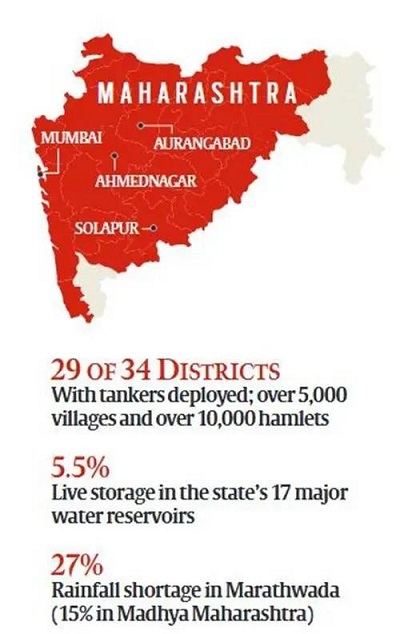Context:
After a deficit in monsoon last year, the Maharashtra government declared many parts of the State drought- hit. Marathwada’s predicament is shaped by its location, topography, soil type, agricultural practices, and crop choices.
What is the Rain-Shadow Effect?
Marathwada lies in the rain-shadow region of the Western Ghats. When moist winds from the Arabian Sea encounter these mountains, they rise and cool, causing heavy rainfall (2,000-4,000 mm) on the western side. However, by the time these winds cross the Ghats and descend into Western Maharashtra and Marathwada, they lose most of their moisture, leaving Marathwada much drier (600-800 mm).
A 2016 study by IIT Gandhinagar researchers noted that climate change is worsening the situation in central Maharashtra. The region has experienced an increasing trend in drought severity and frequency of late. Consequently, Marathwada and North Karnataka have emerged as the second driest regions in India after Rajasthan.
How Does This Affect Crops?
● Ill- Suited Agricultural Practices
o Marathwada’s agricultural practices are ill-suited to its low rainfall, with sugarcane cultivation being a major contributor to the region's water crisis. Sugarcane requires 1,500-2,500 mm of water during its growing season and needs near-daily irrigation. Despite occupying only 4% of the cropped area, sugarcane consumes 61% of the region’s irrigation water, significantly reducing river outflow in the upper Bhima basin.
● Government Support and Water Availability
o Government support for sugarcane pricing has driven its expansion, limiting water availability for more nutritious crops such as pulses and millets which require four or five irrigations across their crop life, whereas, sugarcane needs to be irrigated almost every day. Although the Maharashtra Water and Irrigation Commission recommended banning sugarcane in areas receiving less than 1,000 mm of rainfall, production has increased, with 82% of Maharashtra's sugarcane grown in low-rainfall areas.
|
Water Crisis in India
|
How Do Soil and Topography Matter?
● Soil Characteristics and Impact on Agriculture
o Marathwada’s clayey black soil, known as "regur," is fertile and retains moisture well but has a low infiltration rate, causing water to either log or run off without recharging groundwater. To capture this runoff, Maharashtra has built numerous dams, making it the state with the most large dams (1,845) in the country. Despite this, the soil’s low hydraulic conductivity leads to prolonged water retention after rains, resulting in crop losses for farmers.
● Variability of Water Scarcity in Marathwada
o Water scarcity in Marathwada is uneven. The region has parallel tributaries of the Godavari and Krishna rivers, with valleys having perennial groundwater and uplands having seasonal groundwater. Groundwater moves from uplands to valleys, causing wells in upland areas to dry up a few months after the monsoons, leading to acute water scarcity. These areas are at a natural disadvantage and need special support.
Can Marathwada Be Water-Resilient?
- Supply-Side Solutions for Water Management: Supply-side solutions are about making the most of available resources. They include classical watershed management work, such as building water-conserving structures like contour trenches, earthen bunds, gully plugs, etc.
- Silt Management and Farmer Training: Second, rainwater that runs off agricultural fields carries the very soil that doesn’t allow the water to percolate. Many of these structures accumulate silt. Funds under the Mahatma Gandhi National Rural Employment Guarantee Scheme could be used to design silt-trapping mechanisms and organize training programmes for farmers on periodic desilting.
- Water Demand Management and Crop Diversification: In a low-rainfall region, managing water demand includes practicing water-efficient irrigation, cultivating drought-resistant crops like millets and pulses, and diversifying livelihoods. Marathwada must also shift to other high-value, low-water-using crops, while sugarcane production must move to Uttar Pradesh, Bihar, and West Bengal.
- Water Conservation: Promoting techniques like drip irrigation and sprinkler systems can significantly reduce water usage in agriculture. Encouraging individuals and communities to harvest rainwater for domestic and agricultural purposes can create a buffer during dry spells.
- Water Resource Management: Lining canals with concrete or other materials can minimize water loss due to seepage. Identifying and fixing leaks in water infrastructure can prevent precious water from being wasted. Restoring and maintaining traditional water bodies like ponds and tanks can supplement water supplies.
- Policy and Governance: Introducing stricter regulations on groundwater extraction and implementing water pricing that reflects its true value can discourage overuse. Educating the public about water conservation practices and the importance of sustainable water management is crucial for long-term success.
- Technological Solutions: While energy-intensive, desalination plants can offer a source of freshwater in coastal areas. Treating wastewater for reuse in agriculture or non-potable purposes can lessen the demand for freshwater.
Conclusion
Maharashtra faces significant water stress, with varying levels of water availability across different regions. The rain-shadow effect, unsuitable crop choices like sugarcane in low-rainfall areas, and soil and topography challenges exacerbate the situation. To mitigate the crisis, the State must adopt a multifaceted approach that includes both supply-side and demand-side solutions. By implementing watershed management practices, promoting water-efficient irrigation, and shifting to more appropriate crops, Maharashtra can work towards achieving water resilience.
|
Probable Questions for UPSC Mains Exam-
|
Source- The Hindu







